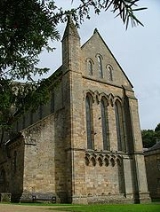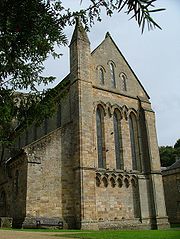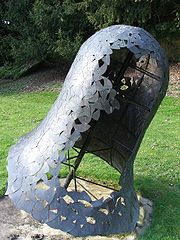
Brinkburn Priory
Encyclopedia
Brinkburn Priory lies on a bend of the River Coquet
, some 4 miles (6 km) east of Rothbury
, Northumberland
, England
.
as an Augustinian
priory
. The exact date is not known but cannot have been later than 1135 as Henry died that year.
About 1180 or so, Brinkburn became an independent house, and the building of the monastic church was commenced. Although the Priory acquired lands in Northumberland
and Durham
over the years it was never particularly wealthy. Little is known of the early history of the priory, although it is known that it survived some difficult times. In fact, as late as 1419 it was raided and robbed.
Services continued to be held at Brinkburn and the church was retained in a fair state of repair till the end of the 16th century. In 1602 it was reported to be in a state of decay, and before 1700, the roof had collapsed, regular services were abandoned, and the site was deserted.
The estate was purchased by the Fenwick family and in the late 16th century they built a manor house on the runs of the Priory buildings and adjacent to the ruins of the Priory Church
In the 19th century the Cadogan family, owners of Brinkburn revived the restoration of the church and work began in 1858. The roof was completed in the space of a year, and the stained glass windows had been inserted by 1864. The church, however, was not furnished until 1868.
The tombstone of Prior William, Bishop of Durham (died 1484) was found during the reconstruction, as was the original altar stone with five crosses. The latter is still preserved along with an ancient font. In 1834 a bronze pot containing 300 Rose Nobles of Edward III
, Richard II
, and Henry IV
was also discovered.
Brinkburn Priory today, is a very sympathetic 19th-century restoration
of the mediæval
original. On the site of the west range, is an early-19th-century manor house
which utilizes part of the vaulted undercroft to the monks dining hall.
Church services and concerts are still occasionally held here, but mostly, Brinkburn Priory today is a peaceful and tranquil place.
Brinkburn Mill
, once part of the Priory precinct, still stands, having been bought and refurbished in 1990 by the Landmark Trust
.


River Coquet
The River Coquet runs through the county of Northumberland, England, discharging into the North Sea on the east coast of England at Amble. Warkworth Castle is built in a loop of the Coquet....
, some 4 miles (6 km) east of Rothbury
Rothbury
Rothbury is a town and civil parish in Northumberland, England. It is located on the River Coquet, northwest of Morpeth and north-northwest of Newcastle upon Tyne...
, Northumberland
Northumberland
Northumberland is the northernmost ceremonial county and a unitary district in North East England. For Eurostat purposes Northumberland is a NUTS 3 region and is one of three boroughs or unitary districts that comprise the "Northumberland and Tyne and Wear" NUTS 2 region...
, England
England
England is a country that is part of the United Kingdom. It shares land borders with Scotland to the north and Wales to the west; the Irish Sea is to the north west, the Celtic Sea to the south west, with the North Sea to the east and the English Channel to the south separating it from continental...
.
Early history
It was founded by William Bertram, Baron of Mitford, in the reign of Henry IHenry I of England
Henry I was the fourth son of William I of England. He succeeded his elder brother William II as King of England in 1100 and defeated his eldest brother, Robert Curthose, to become Duke of Normandy in 1106...
as an Augustinian
Augustinians
The term Augustinians, named after Saint Augustine of Hippo , applies to two separate and unrelated types of Catholic religious orders:...
priory
Priory
A priory is a house of men or women under religious vows that is headed by a prior or prioress. Priories may be houses of mendicant friars or religious sisters , or monasteries of monks or nuns .The Benedictines and their offshoots , the Premonstratensians, and the...
. The exact date is not known but cannot have been later than 1135 as Henry died that year.
About 1180 or so, Brinkburn became an independent house, and the building of the monastic church was commenced. Although the Priory acquired lands in Northumberland
Northumberland
Northumberland is the northernmost ceremonial county and a unitary district in North East England. For Eurostat purposes Northumberland is a NUTS 3 region and is one of three boroughs or unitary districts that comprise the "Northumberland and Tyne and Wear" NUTS 2 region...
and Durham
Durham
Durham is a city in north east England. It is within the County Durham local government district, and is the county town of the larger ceremonial county...
over the years it was never particularly wealthy. Little is known of the early history of the priory, although it is known that it survived some difficult times. In fact, as late as 1419 it was raided and robbed.
Dissolution
In 1535 the value was recorded as £69 and the priory, having an income of less than £200 per annum, was finally dissolved in 1536.Services continued to be held at Brinkburn and the church was retained in a fair state of repair till the end of the 16th century. In 1602 it was reported to be in a state of decay, and before 1700, the roof had collapsed, regular services were abandoned, and the site was deserted.
The estate was purchased by the Fenwick family and in the late 16th century they built a manor house on the runs of the Priory buildings and adjacent to the ruins of the Priory Church
Modern history
In the 1750s Thomas Sharp, Archdeacon of Northumberland, tried to effect repairs to the ruin. Although there was considerable support for the project, work was called off after a dispute between the owner William Fenwick and the Vicar of Felton.In the 19th century the Cadogan family, owners of Brinkburn revived the restoration of the church and work began in 1858. The roof was completed in the space of a year, and the stained glass windows had been inserted by 1864. The church, however, was not furnished until 1868.
The tombstone of Prior William, Bishop of Durham (died 1484) was found during the reconstruction, as was the original altar stone with five crosses. The latter is still preserved along with an ancient font. In 1834 a bronze pot containing 300 Rose Nobles of Edward III
Edward III of England
Edward III was King of England from 1327 until his death and is noted for his military success. Restoring royal authority after the disastrous reign of his father, Edward II, Edward III went on to transform the Kingdom of England into one of the most formidable military powers in Europe...
, Richard II
Richard II of England
Richard II was King of England, a member of the House of Plantagenet and the last of its main-line kings. He ruled from 1377 until he was deposed in 1399. Richard was a son of Edward, the Black Prince, and was born during the reign of his grandfather, Edward III...
, and Henry IV
Henry IV of England
Henry IV was King of England and Lord of Ireland . He was the ninth King of England of the House of Plantagenet and also asserted his grandfather's claim to the title King of France. He was born at Bolingbroke Castle in Lincolnshire, hence his other name, Henry Bolingbroke...
was also discovered.
Brinkburn Priory today, is a very sympathetic 19th-century restoration
Victorian restoration
Victorian restoration is the term commonly used to refer to the widespread and extensive refurbishment and rebuilding of Church of England churches and cathedrals that took place in England and Wales during the 19th-century reign of Queen Victoria...
of the mediæval
Middle Ages
The Middle Ages is a periodization of European history from the 5th century to the 15th century. The Middle Ages follows the fall of the Western Roman Empire in 476 and precedes the Early Modern Era. It is the middle period of a three-period division of Western history: Classic, Medieval and Modern...
original. On the site of the west range, is an early-19th-century manor house
Manor house
A manor house is a country house that historically formed the administrative centre of a manor, the lowest unit of territorial organisation in the feudal system in Europe. The term is applied to country houses that belonged to the gentry and other grand stately homes...
which utilizes part of the vaulted undercroft to the monks dining hall.
Church services and concerts are still occasionally held here, but mostly, Brinkburn Priory today is a peaceful and tranquil place.
Brinkburn Mill
Brinkburn Mill
Brinkburn Mill is a water mill located near Rothbury, in Northumberland. It once formed part of the precincts of Brinkburn Priory and was constructed in around 1800 on the site of a former medieval mill. After the dissolution of the monasteries, the Priory, and its Mill, were owned by Fenwicks of...
, once part of the Priory precinct, still stands, having been bought and refurbished in 1990 by the Landmark Trust
Landmark Trust
The Landmark Trust is a British building conservation charity, founded in 1965 by Sir John and Lady Smith, that rescues buildings of historic interest or architectural merit and then gives them a new life by making them available for holiday rental...
.
See also


- Devil's CausewayDevil's CausewayThe Devil's Causeway is a Roman road in Northumberland, in North East England. It branches off Dere Street north of Corbridge and can be traced through Northumberland for about north to Berwick-upon-Tweed.-Description:...
which passes the priory less than 1 miles (2 km) to the east (where it crosses the River CoquetRiver CoquetThe River Coquet runs through the county of Northumberland, England, discharging into the North Sea on the east coast of England at Amble. Warkworth Castle is built in a loop of the Coquet....
). The causeway is a RomanAncient RomeAncient Rome was a thriving civilization that grew on the Italian Peninsula as early as the 8th century BC. Located along the Mediterranean Sea and centered on the city of Rome, it expanded to one of the largest empires in the ancient world....
road which starts at Port Gate on Hadrian's WallHadrian's WallHadrian's Wall was a defensive fortification in Roman Britain. Begun in AD 122, during the rule of emperor Hadrian, it was the first of two fortifications built across Great Britain, the second being the Antonine Wall, lesser known of the two because its physical remains are less evident today.The...
, north of CorbridgeCorbridgeCorbridge is a village in Northumberland, England, situated west of Newcastle and east of Hexham. Villages in the vicinity include Halton, Acomb, Aydon and Sandhoe.-Roman fort and town:...
, and extends 55 miles (89 km) northwards across Northumberland to the mouth of the River TweedRiver TweedThe River Tweed, or Tweed Water, is long and flows primarily through the Borders region of Great Britain. It rises on Tweedsmuir at Tweed's Well near where the Clyde, draining northwest, and the Annan draining south also rise. "Annan, Tweed and Clyde rise oot the ae hillside" as the Border saying...
at Berwick-upon-TweedBerwick-upon-TweedBerwick-upon-Tweed or simply Berwick is a town in the county of Northumberland and is the northernmost town in England, on the east coast at the mouth of the River Tweed. It is situated 2.5 miles south of the Scottish border....
.
External links
- Brinkburn Priory - official site at English Heritage
- Events at Brinkburn Priory
- Brinkburn Priory image—Nashford Publishing
- Brinkburn image—Britannia
- Find public transport to Brinkburn Priory—buses stop about 700 yards (640.1 m) from the priory

